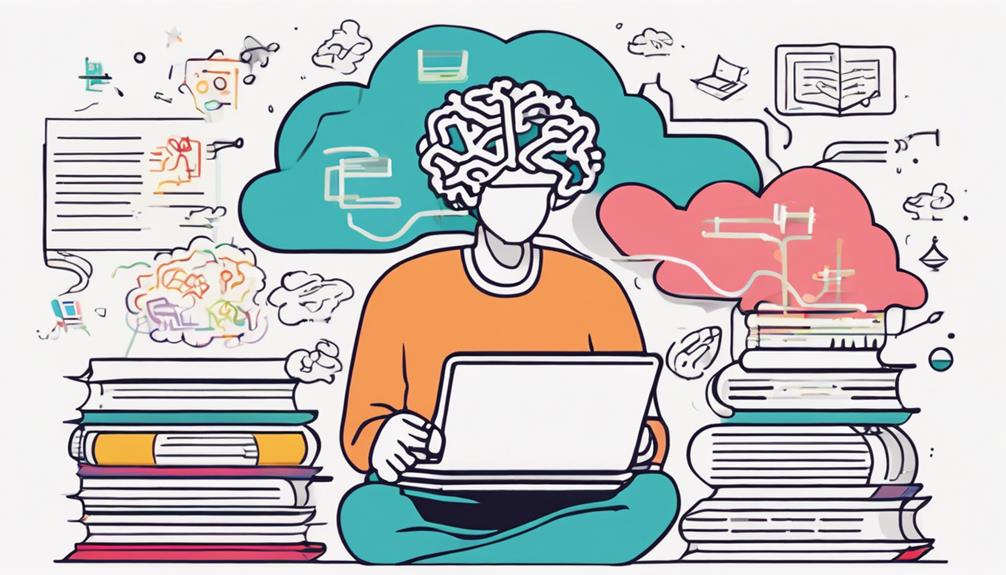Self-paced learning, a method gaining traction in educational spheres, offers a unique approach that grants individuals the freedom to navigate their learning journey autonomously. This model allows for a tailored learning experience, accommodating diverse learning preferences effectively. The flexibility and personalized nature of self-paced learning provide learners with a sense of control over their educational path, influencing outcomes positively. Understanding the nuances and benefits of this approach can shed light on its significance in modern education.
Key Takeaways
- Self-paced learning allows for autonomy and individual progress tracking.
- It enhances knowledge retention through personalized experiences.
- Flexible learning pace accommodates diverse styles and needs.
- Creating a conducive study environment boosts focus and productivity.
Understanding Self-Paced Learning

Self-paced learning is a pedagogical approach that empowers individuals to advance through educational material autonomously, tailored to their own pace and preferences. This method allows learners the flexibility to access and engage with course content according to their unique needs and schedules. By enabling personalized learning experiences, self-paced learning puts the control of the learning process in the hands of the learner, promoting autonomy and self-regulated learning habits.
One of the key benefits of self-paced learning is the individualized progress tracking it offers. Learners can monitor their advancement through the material, focusing more on challenging topics while swiftly moving through familiar ones. Moreover, the absence of rigid time constraints allows individuals to devote more time to areas that require additional attention, ultimately leading to a deeper understanding of the subject matter. This approach accommodates diverse learning styles by catering to the specific requirements of each learner, making it an increasingly popular choice in the educational landscape.
Benefits of Self-Paced Learning
Enhancing individualized knowledge retention and acquisition, self-paced learning offers a flexible educational approach that caters to diverse learning styles and preferences. Personalized learning is a key benefit of self-paced learning, as it allows individuals to progress at their own speed and focus on areas where they need more support. This tailored approach enhances retention rates and knowledge acquisition compared to traditional classroom settings. Moreover, self-paced learning enables individuals to manage their time effectively, promoting the development of essential time management skills. By setting their own schedules for learning, individuals can reduce pressure and anxiety, leading to a more conducive learning environment.
In addition to benefiting individuals, organizations can also reap rewards from self-paced learning. Employees engaging in self-paced learning can develop self-discipline and improve their time management skills, which are valuable assets in the workplace. Furthermore, organizations can save time and resources by implementing self-paced learning through online tools and learning management systems, making it a cost-effective and efficient training solution.
Flexibility in Learning Speed

Self-paced learning offers a unique advantage by allowing individuals to customize their learning pace based on their understanding and comfort with the material. This flexibility enables learners to track their progress effectively, ensuring that they can focus on challenging topics while swiftly navigating through familiar content. By tailoring the learning speed to individual needs, self-paced learning provides a personalized approach that supports diverse learning styles and preferences.
Customized Learning Pace
Customizing the pace of learning to accommodate individual preferences and abilities is a key aspect of self-directed educational approaches. Self-paced learning allows individuals to tailor their learning experience according to their needs, progressing through material at a speed that suits them best. This method offers the flexibility to delve deeper into challenging topics while swiftly navigating through familiar concepts. Research indicates that self-paced learning can improve retention rates and enhance overall comprehension. By adjusting the speed of learning to fit their schedule and preferences, individuals can effectively manage their time. Moreover, this approach is advantageous for catering to diverse learning styles and preferences, thereby creating a more personalized and effective educational experience.
Individual Progress Tracking
Individual progress tracking in self-paced learning systems allows for a personalized approach to education, enabling learners to advance at their own pace without the constraints of a predefined schedule. Through the use of learning management systems, individual progress can be monitored and assessed, offering valuable insights into each learner's comprehension and retention levels. This data-driven approach enables educators to tailor their instruction to meet the specific needs of each student, ensuring a more efficient and effective learning process. Learners benefit from the flexibility to review and revisit content as needed, promoting a deeper understanding of the material. By tracking individual progress, self-paced learning systems empower learners to take control of their education and achieve mastery in a way that aligns with their unique learning styles and preferences.
Customized Learning Schedules
The flexibility afforded by tailored learning schedules in self-paced learning enhances the overall learning experience for individuals. Customized learning schedules offer learners the opportunity to manage their time effectively and adapt the learning process to their specific needs. Here are four key benefits of customized learning schedules in self-paced learning:
- Time Management: Learners can allocate study time based on their availability, optimizing productivity and efficiency.
- Flexibility: Individuals have the freedom to choose when and how they engage with course materials, accommodating different learning preferences.
- Personalized Learning Experiences: Tailored schedules allow for a personalized approach, catering to each learner's pace and style.
- Increased Engagement and Motivation: Customized learning schedules contribute to higher levels of engagement and motivation, as learners take ownership of their learning journey.
Enhanced Information Retention

Enhancing information retention in self-paced learning environments is supported by the flexibility for learners to review and revisit course materials at their own pace. Studies indicate that self-paced learning can lead to increased information retention rates. The autonomy and control afforded to learners in self-paced settings empower them to engage deeply with the content, which contributes to better retention of the information presented. This personalized learning experience allows individuals to focus on challenging concepts until they are fully understood, promoting retention over time.
Reduced Distractions
Reduced distractions in self-paced learning play a crucial role in enhancing the learners' ability to focus on the task at hand. The personalized learning experience allows individuals to choose study times that align with their peak concentration periods, minimizing external disruptions. By offering control over the learning environment, self-paced learning enables learners to effectively manage distractions and optimize their study conditions.
Focus on Task
In self-paced learning, individuals' ability to focus on a task is significantly enhanced by minimizing external distractions. This focused approach allows learners to engage more deeply with the material, leading to improved comprehension and retention. To understand the impact of reduced distractions on task focus, consider the following:
- Time Allocation: Learners can dedicate specific time slots to learning, ensuring uninterrupted periods of focus.
- Control Over Pace: The ability to set one's own learning speed enables individuals to delve into topics without feeling rushed or held back.
- Environmental Management: Creating a conducive study environment free from disturbances enhances concentration on the task at hand.
- Productivity Boost: Reduced interruptions lead to increased productivity, as learners can fully immerse themselves in the learning process.
Personalized Learning Experience
A key aspect of self-paced learning lies in the tailored educational experience it offers, where individuals can immerse themselves in focused study without the interference of external distractions. This personalized learning experience allows learners to adjust the pace of their education according to their requirements, leading to improved comprehension and retention of knowledge. The reduced distractions in self-paced learning environments create an opportunity for students to concentrate fully on the material being studied. By providing personalized learning experiences, self-paced settings can significantly enhance motivation and engagement in the learning process. The absence of external disturbances fosters a conducive learning environment that promotes deep understanding and better assimilation of information, highlighting the advantages of self-paced learning in delivering a more effective educational experience.
Catering to Various Learning Styles

To effectively cater to various learning styles within self-paced learning environments, diverse instructional modalities are strategically integrated. Incorporating a range of approaches ensures that learners with different preferences can engage with the material effectively. Here are some key strategies:
- Multimodal Content Delivery: Providing a mix of videos, audio clips, text-based content, and hands-on activities allows learners to choose the format that best suits their learning style.
- Interactive Learning Opportunities: Offering options like interactive quizzes, group discussions, or individual projects caters to learners who thrive in different types of engagement.
- Adaptive Technologies: Utilizing adaptive learning technologies can personalize the learning experience to align with individual preferences, enhancing the effectiveness of self-paced learning for diverse learners.
- Flexible Assessment Formats: By offering a variety of assessment formats such as multiple-choice quizzes, essays, presentations, or practical demonstrations, self-paced learning environments can accommodate the diverse ways in which learners showcase their understanding.
Implementing Self-Paced Learning in Organizations
Implementing self-paced learning in organizations presents a strategic approach to enhancing employee knowledge and skills. By offering flexibility in learning schedules and providing easy access to training materials, organizations can boost engagement and motivation among their employees. The benefits of self-paced learning extend beyond traditional training methods, leading to a more efficient and effective learning environment within the organizational setting.
Organizational Benefits of Self-Paced Learning
The integration of self-paced learning into organizational training frameworks offers significant advantages in fostering employee development and organizational efficiency.
- Online tools like learning management systems provide easy access to training materials.
- Flexibility in deadlines and learning schedules accommodates diverse organizational needs.
- Enhanced knowledge and skills of employees and customers lead to improved performance.
- Cost savings and increased efficiency in training processes are key benefits of self-paced learning in organizations.
Implementing self-paced online learning through learning management systems can revolutionize how organizations approach training, creating a more personalized and effective learning experience for all members.
Strategies for Successful Implementation
Self-paced learning in organizations can be effectively implemented through strategic utilization of online tools and personalized learning approaches to enhance training outcomes and engagement. By leveraging online training platforms and learning management systems, organizations can provide students with easy access to a wealth of training materials. Offering flexibility in deadlines and schedules allows participants to progress at their own pace, fostering a personalized learning experience. This approach caters to the diverse learning needs of individuals, ultimately leading to improved learning outcomes. Moreover, the self-paced nature of online training promotes increased engagement among students, as they have the freedom to structure their learning according to their preferences and capabilities. Successful implementation of self-paced learning strategies is crucial for organizations aiming to optimize training effectiveness and participant satisfaction.
Employee Engagement and Motivation
Employee engagement and motivation are crucial factors to consider when integrating self-paced learning programs within organizational training frameworks. Implementing self-paced learning can have a significant impact on employee participation and interest, leading to a more engaged workforce. Here are some key points to consider:
- Flexibility with deadlines and learning schedules can boost employee engagement.
- Self-paced learning empowers employees to take control of their learning journey, increasing motivation.
- Easy access to training materials through online platforms enhances employee willingness to learn.
- Utilizing learning management systems can efficiently implement self-paced learning and monitor employee progress.
Utilizing Self-Paced Learning With Easy LMS
How can Easy LMS facilitate effective self-paced learning strategies for participants seeking flexibility and personalized learning experiences? Easy LMS offers a user-friendly platform that enables the creation and sharing of tests and courses tailored for self-paced learning. This online learning tool accommodates various sharing methods, catering to different preferences and learning styles of participants. By allowing individuals to learn at their own pace, Easy LMS enhances understanding and knowledge retention. Moreover, the platform provides access to detailed results and statistics, empowering both learners and instructors to review performance and make informed decisions for improving the learning process. One of the key advantages of utilizing Easy LMS for self-paced learning is the effective resolution of scheduling issues. Participants can engage with the material at times that suit them best, leading to a more efficient and personalized learning experience. Easy LMS serves as a valuable resource for implementing self-paced learning strategies in online education, promoting flexibility and optimizing learning outcomes.
Resources for Self-Paced Learning

With the abundance of resources available, individuals engaging in autonomous learning can tap into a wealth of educational materials to support their self-paced learning journeys. When pursuing self-paced learning, consider the following resources:
- National Center for Biotechnology Information (NCBI): Offers valuable insights and research studies on self-paced learning, aiding in a deeper understanding of this educational approach.
- E-learning Industry: Provides comprehensive information on the benefits and practical implementation strategies of self-paced learning, helping learners make informed decisions.
- FAQs Sections: Cover common queries related to self-paced learning, including its advantages and application across different educational settings, offering clarity and guidance.
- Online Learning Platforms like Easy LMS: Equip individuals with tools for creating and sharing self-paced courses efficiently, enhancing the customization and flexibility of learning experiences.
Exploring Self-Paced Learning FAQs
Exploring Self-Paced Learning FAQs provides an in-depth examination of common inquiries regarding the practice of autonomous learning, shedding light on its intricacies and applications within educational contexts. Self-paced learning offers learners the flexibility to control the speed and progression of their learning, making it an ideal choice for individuals with varying learning paces. This approach allows learners to schedule their study times and complete assignments at their convenience, reducing the pressure often associated with traditional learning environments. Moreover, organizations can leverage online tools and learning management systems to implement self-paced learning, enhancing employee training and development.
One significant advantage of self-paced learning is its accommodation of different learning styles, thereby increasing retention rates among participants. By utilizing Easy LMS, organizations can create and share courses and tests tailored to individual learning speeds, enabling participants to engage with the material at their own pace. Overall, the online nature of self-paced learning provides a convenient and effective platform for acquiring knowledge and skills.
Further Reading on Self-Paced Learning

Delving into additional resources on self-paced learning elucidates various strategies and insights for optimizing autonomous learning experiences. When considering further reading on self-paced learning, one can explore the following advantages, pros, and cons:
- Advantages of Self-Paced Learning:
- Personalized learning experience tailored to individual needs.
- Flexibility in scheduling and pacing of learning activities.
- Promotes self-discipline and time management skills.
- Enables learners to revisit and review material as needed.
- Pros of Self-Paced Learning:
- Lower stress levels compared to traditional classroom settings.
- Increased retention of information due to customized learning paths.
- Access to a wide range of online resources and courses.
- Encourages autonomy and self-directed learning.
- Cons of Self-Paced Learning:
- Potential for procrastination without strict deadlines.
- Lack of real-time interaction with instructors and peers.
- Requires strong self-motivation and discipline.
- Possibility of feeling isolated without a traditional classroom environment.
Frequently Asked Questions
What Is the Meaning of Self-Paced Learning?
Flexible scheduling and personalized progress are inherent aspects of self-paced learning. This approach enables individuals to dictate the pace and timing of their educational journey, granting them the freedom to engage with course material as per their convenience. By offering tailored learning paths that align with individual needs and preferences, self-paced learning diverges from traditional classroom instruction, providing learners with increased time flexibility and control over their educational experience.
What Is an Example of Self Paced Training?
One example of self-paced training is online coding courses, where learners can progress through modules at their own pace. This format allows individuals to fit learning around their schedules and preferences. A study by Forbes showed that 95% of organizations believe self-paced training helps with employee retention. The benefits of self-paced training include flexibility, personalized learning, and increased knowledge retention through interactive activities.
What Is the Self Pacing Method of Teaching?
The self-pacing method of teaching involves promoting independent study and personalized progress for learners. It allows students to advance through course material at their own pace, catering to individual learning needs and preferences. This approach offers a flexible schedule and customized learning experience, enabling students to engage with content at times that best suit them. By providing autonomy and control over one's learning journey, self-pacing contrasts with traditional classroom-based instruction.
What Is the Self-Paced Learning Model?
The self-paced learning model enables individuals to engage in a personalized approach to education by providing a flexible schedule that caters to student autonomy and individual progress. This method allows learners to navigate through educational materials at their own speed, promoting a sense of independence and self-regulation. By offering a customized learning experience without strict deadlines, self-paced learning fosters a conducive environment for diverse learning styles to thrive.
Conclusion
In conclusion, self-paced learning offers a flexible and personalized approach to education, allowing individuals to progress at their own speed and convenience. This method enhances information retention and enables customized learning schedules, catering to different learning styles effectively. By utilizing self-paced learning with tools like Easy LMS and accessing resources available, learners can enjoy the journey of acquiring knowledge at their own pace, ultimately reaping the benefits of this idyllic educational approach.
